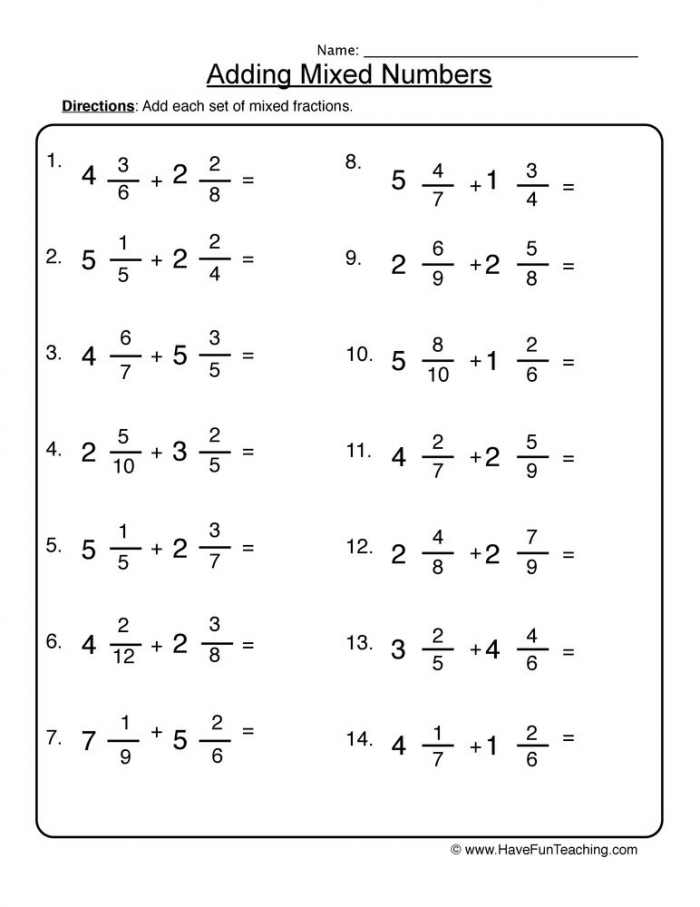

Notice that you should borrow only after you have identified a common denominator. (You borrowed 1 in the form of from the 1's column.) Note:When you borrow 1 from the whole number, the 1 must be changed to a fraction. When you subtract mixed numbers, you sometimes may have to rename the whole number, just as you sometimes borrow from the next column when subtracting whole numbers. In that case, you must change the improper fraction to a mixed number and combine it with the sum of the integers. Sometimes, you may end up with a mixed number that includes an improper fraction. To add mixed numbers, the same rule as in adding fractions applies (find the LCD), but make sure that you always add the whole numbers to get your final answer. But also note the differences and the reminders given in this section. You will notice that the steps in adding and subtracting mixed numbers are similar.

Quiz: Variables and Algebraic Expressions.Variables Algebraic Expressions and Simple Equations.Quiz: Arithmetic Progressions and Geometric Progressions.Quiz: Calculating Measurements of Basic Figures.Calculating Measurements of Basic Figures.Customary System, Metric System, and Converting Units of Measure Rationals (Signed Numbers Including Fractions).Quiz: Rationals (Signed Numbers Including Fractions).Quiz: Changing Percents, Decimals, and Fractions, and Important Equivalents.Changing Percents, Decimals, and Fractions.Quiz: Changing Fractions to Decimals, Changing Terminating Decimals to Fractions, and Changing Infinite Repeating Decimals to Fractions.Changing Infinite Repeating Decimals to Fractions.Changing Terminating Decimals to Fractions.Quiz: Simplifying Fractions and Complex Fractions.Simplifying Fractions and Complex Fractions.Quiz: Multiplying and Dividing Fractions and Mixed Numbers.Multiplying Fractions and Mixed Numbers.Quiz: Adding and Subtracting Fractions and Mixed Numbers.Quiz: Proper and Improper Fractions, Mixed Numbers, and Renaming Fractions.Quiz: Factors, Primes, Composites, and Factor Trees.Factors, Primes, Composites, and Factor Trees.Quiz: Estimating Sums, Differences, Products, and Quotients.Estimating Sums, Differences, Products, and Quotients.Quiz: Grouping Symbols and Order of Operations.Ways to Show Multiplication and Division.Grouping Symbols and Order of Operations.Quiz: Properties of Basic Mathematical Operations.Properties of Basic Mathematical Operations.If Ron has 1 1 dollar and 1 1 quarter, he has 1 1 4 1 1 4 dollars. Let’s begin by thinking about addition of mixed numbers using money.

So far, we’ve added and subtracted proper and improper fractions, but not mixed numbers. Quiz: Ways to Show Multiplication and Division, Multiplying and Dividing by Zero, and Common Math Symbols Model Addition of Mixed Numbers with a Common Denominator.sets that include both wholes and fractional parts.) After students demonstrate mastery for combining sets with “wholes” and fractional parts, then begin introducing the mathematical language and mathematical symbols in conjunction with the concrete materials. Ability to add common fractions with like denominators.ġ) Combine two sets of concrete materials that represent fractions with mixed numbers.Ģ) Solve story problems involving addition of fractions with mixed numbers using concrete materials.ģ) Solve equations involving addition of fractions with mixed numbers using concrete materials.ġ) It is important to first provide students with “pure” concrete experiences where students combine sets of concrete objects that represent fractions with mixed numbers (e.g.Ability to identify concrete representations of fractional parts and wholes.Math Skill/Concept: Adding Fractions with Mixed Numbers (Like Denominators) using concrete materials.

Prerequisite Skills - Learning Objectives - Important Ideas for Implementationĭownload printable version of this teaching plan, with additional detailed descriptions


 0 kommentar(er)
0 kommentar(er)
